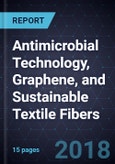This issue of the High-Tech Materials TOE covers the latest innovations in the field of antimicrobial technology, graphene, and sustainable textile fibers. These innovations can be used in a wide variety of energy storage applications (such as batteries, supercapacitors, and fuel cells), textiles, and healthcare. This issue also covers the development of sustainable textile fibers from squid genes.
The High-Tech Materials TechVision Opportunity Engine (TOE) provides intelligence on technologies, products, processes, applications, and strategic insights on various materials across industries. Some material technologies include lightweight materials, bio–based materials, ceramics, smart materials, fibers, nanomaterials, responsive materials, polymers, woven and non woven materials, polymers and plastics and packaging materials.
The Chemicals and Advanced Materials cluster tracks research and innovation trends and developments across specialty chemicals, plastics, polymers, chemicals, bio-chemicals, metals, coatings, thinfilms, surface treatments, composites, alloys, oil and gas, fuel additives, fibers, and several other related technologies and its impact and application across industries.
Table of Contents
1. Advancements in Antimicrobial Technology, Graphene, and Sustainable Textile Fibers
- Graphene Oxide-based Batteries Have the Potential to Enhance the Charge/Discharge Cycles
- Graphene-based Battery with the Potential To Have a Quarter Million Cycle Life
- Catalysts that Are Used in Fuel Cells Are Made of Ruthenium Atoms
- Sustainable Textiles that Are Developed from Squid Genes
- Antimicrobial Technology that Has the Ability to Provide 99.99% Protection from Gram Positive and Gram Negative Bacteria
2. Key Contacts








